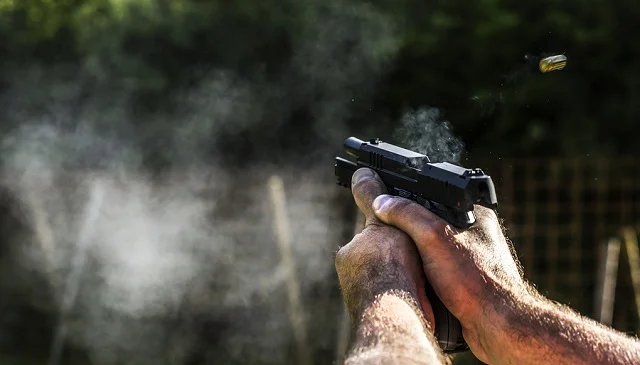
Should You Train To Shoot Center Of Mass?
In a defensive shooting, the established wisdom is to shoot center of mass...but is that really true? There is a lot of conflicting information out there.
Plenty of real-world shootings have involved direct hits to the vitals that failed to stop the target, so is this old saw really worth paying attention to? It's definitely something that might be taught in concealed carry training.
The answer might surprise you.
Shooting Center Mass: Anatomy And Physiology

So, why are people taught to shoot center of mass? Part of it comes down to human anatomy.
Concurrently, hunter's education courses likewise teach prospective big game hunters to shoot for the same general area. Why? All the same reasons, which we're about to get into.
So, when people say "center of mass" what they're actually talking about is the chest cavity. This portion of the human body contains the cardiovascular and pulmonary systems, ie the heart and lungs, as well as assorted veins, arteries and the thoracic spine.
In other words, this area of the human body contains some organs and other stuff that is essential to sustaining life, more so than any other part of the body. Trauma, such as that done by a bullet, can more easily be fatal than the same trauma done to, say, a wound to the abdomen or a wound to the leg. Not that fatalities cannot or have not occurred due to wounds to those areas, more that there is a greater chance of fatality with traumatic injury to the chest.
So, a bullet in the chest is more likely to make a bad guy dead according to Gray's Anatomy. (The medical textbook, not that contemptible soap opera.) But what about in the real world?
Failure To Stop
Another truth about center of mass is that center-of-mass hits have completely, utterly and totally failed to stop people.
Take, for instance, the account of Tim Gramins. Gramins, at the time of his 2007 shootout, was a police officer in Skokie, Ill. He engaged in a shootout with an armed assailant who did not intend on being arrested. Gramins fired 33 rounds, striking the suspect 14 times including six shots to vital organs in the center of mass. The fight didn't end until Gramins delivered three shots to the head, according to PoliceOne.
Plenty of other instances like this exist; after all, the reason for the existence of the "Failure Drill" or "Mozambique Drill" is precisely because a controlled pair to the body failed to stop the target, requiring a headshot. The man who invented it - a mercenary fighting in the Mozambique civil war - had to resort to a headshot to bring down an enemy.
It's a valuable shooting drill, which is why a lot of police departments, militaries and concealed carry training instructors teach it to students.
Ask hunters about how well chest shots work, and you'll get a mixed bag of answers. Some people have placed shots perfectly on deer, elk, black bear or other game, only for their quarry to run off into the brush and tracking to ensue. Sometimes, the animal is recovered within a few hundred yards. Sometimes, they're never found despite a wound that's fatal. Other times, they're hit, then they stagger a few paces, lay down and die. Sometimes they drop in place.
I haven't had too many deer make dramatic escapes despite a hit to the chest cavity. Turkeys, on the other hand...hoo boy. At least twice I've put the bead right on the wattle (this puts the pattern on their head and neck) and fired, only for the bird to get up and run off. In one instance, the blast knocked the bird rear-end over tea kettle, but after a few flaps of his wings, he not only got up and ran but FLEW INTO THE TREES despite a brisket full of Kent #5.
Yes, I feel guilty about wounding the animal; I felt sick to my stomach over it at the time. Obviously, it's my fault for not placing the shot 100 percent correctly but I did everything right. I aimed correctly, squeezed the trigger correctly but still failed to put a pellet where it needed to go. But hunting stories aren't the point here.
The point? That was a 12-lb (best guess; wild turkeys aren't as fat as farm birds) turkey, whose body is about the size of a football. He took a hit from a 3-inch shotgun shell at less than 20 yards to the face and chest, and he still walked away.
A little handgun round? Hitting a human? A center-of-mass hit just isn't the guarantor of a stoppage that you might think. The heart can keep pumping after suffering a lot of trauma, the lungs can keep working.
And don't start with "air in, blood out." Yes, I'm talking to you, .45 caliber guys. Reliable loss of consciousness doesn't set in until blood loss of 40 percent or more so don't even go there.
The universal "off switch" for all living things is the brainstem. Hit that and it's lights out. That would seem to mean that you should train for headshots...right?
Well...here's where things start to take a turn. It's not actually that simple.
Shooting Center Mass Increases Shot Success

The problem posed by headshots vs center-of-mass is that of handgun accuracy under stress.
A person can get pretty good on the range, even practicing from the draw with their carry gun and concealed carry holster. Does that always translate to success in the field?
No. It doesn't.
Most of us would agree that police officers have some proficiency with firearms and specifically with handguns. However, this group of people - who we think of as at least sort of knowing what they're doing - struggle to hit the target in the event they have to use their duty weapon.
A 2008 study by the Rand Corporation of the NYPD looking at officer-involved deadly force incidents between 1998 and 2006 - available from the New York City government - officers of the NYPD had an 18 percent hit rate during gunfights, and a 30 percent hit rate when they had to use deadly force on a suspect that didn't have a gun.
Departments in other cities have also found less-than-flattering hit rates. According to Police One, the Dallas PD found a 35 percent hit rate in 149 officer-involved shootings over a 15-year period.
The LAPD, meanwhile, have apparently been doing something right. According to the LAPD, officer-involved shootings by LAPD officers resulted in hit rates (total rounds fired vs hits) of 29 percent in 2012, 23 percent in 2013, 36 percent in 2014, 50 percent in 2015 and 61 percent in 2016.
Typically, most departments average somewhere under a 30 percent hit rate. These are, remember, trained professionals.
Granted, a few things bear mentioning.
First, the average police officer will never fire a shot in anger in their entire career. Very few officers are involved in more than one officer-involved shooting.
Second, many police officers - who carry a gun every day! - don't train all that much. Many do just enough to keep their jobs, shooting a department qualification every year and barely going to the range in between. In fact, many armed citizens have more handgun training and do more shooting than many police officers.
That doesn't mean they're bad people or bad police officers for doing so. Again, the odds are that they'll never have to use their duty weapon and not every police officer is really into guns. What has been found as well in modern policing is that training in mental health and de-escalation actually results in fewer officers having to draw their guns in the first place. If you read the above report from the LAPD, you'll note that far fewer officer-involved shootings are taking place and those are the reasons why.
Third, and this is the big point: shooting on a range is A LOT different than shooting at someone who is trying to shoot YOU.
An internal review of NYPD shootings in the 1990s found, according to the Atlanta Journal-Constitution found that motor skills declined by up to 30 percent during a fight.
The point?
Professionals, on average, barely hit the target 3 times in 10 in fights. What do you think the odds are that you're going to be able to hit the head under stress?
What this tells us is that Handgun Accuracy Degrades Under Stress. Not ALL brain injuries are disabling or fatal; the brainstem itself is about the size of a bratwurst. Hitting it under stress is a dubious proposition.
In other words: it isn't easy to hit the target when you're under stress, let alone do so with the accuracy and precision needed for a brain shot. So the idea of "well, I'll just shoot the head" isn't likely a viable one.
Why Shoot Center Of Mass? The Law Of Averages

There's a reason why the typical instructor is STILL going to teach you to shoot center of mass today. There's a reason why many police departments and/or militaries teach people to shoot for COM today, too.
It has the greatest probability of doing vital damage or stopping your enemy AND the highest chances for you to be able to deliver the shot on target under stress.
The human head is about the size of a grapefruit. The human chest is about the size of a watermelon. Which are you going to have an easier time hitting if you have to shoot in a hurry? The bigger target, of course!
It's also worth mentioning that more than 80 percent of all people shot with a handgun survive the ordeal. What stops most bad guys is not a wound to the vital organs, though that usually ends up being dealt with in the hospital. Most of the time, it's the sheer psychological shock of "oh my god! I've been shot!!" that does it.
Being shot in the chest certainly helps in delivering that psychological shock. Blood loss and a collapsed lung will also help in that regard.
Headshots vs Center Of Mass

So, should you practice headshots vs center of mass? Or the other way around?
The available evidence suggests that headshots are more effective but you're more likely to be able to pull off a shot to center of mass more easily under stress...but that doesn't mean it will work. Therefore, the best practice is actually to learn BOTH.
I mentioned the Mozambique drill earlier. Also known as the Failure or Failure To Stop drill, it's one of the best practical shooting drills in existence and it should definitely be in your practice routine.
Which, as it happens, is why it's part of a lot of handgun training courses. It's taught by most police departments and many militaries, and for good reason!
It's not so much this or that, but that you need to be able to do both. You can't rely on one or the other; both should be in the toolbox, so to speak.









